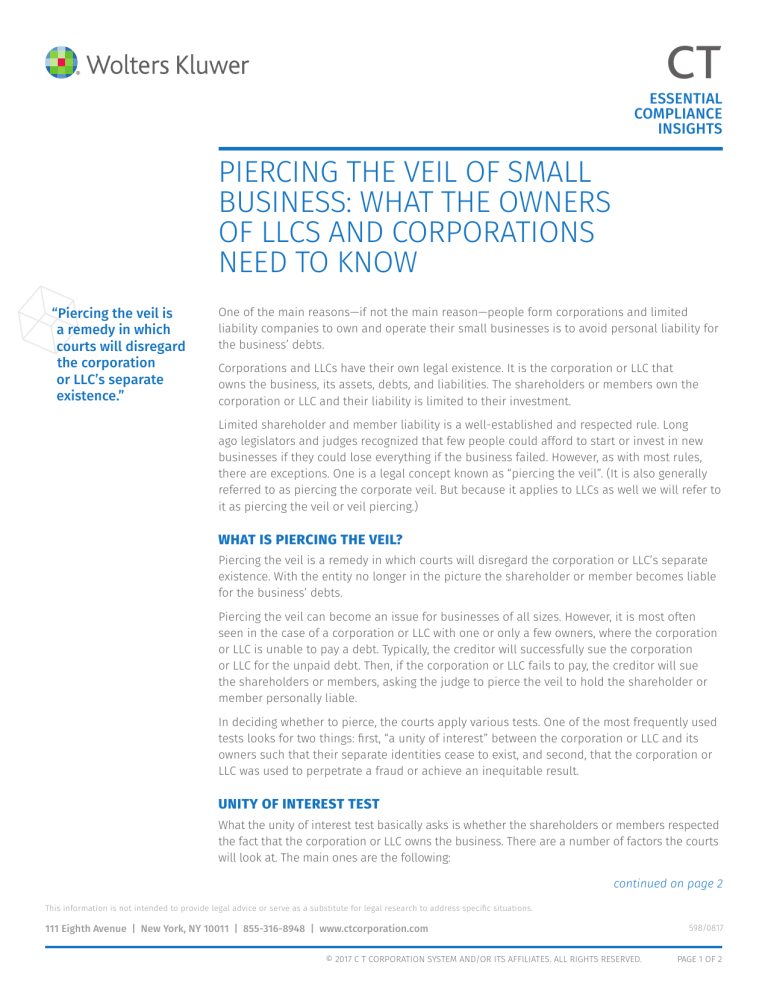
CT
ESSENTIAL
COMPLIANCE
INSIGHTS
PIERCING THE VEIL OF SMALL
BUSINESS: WHAT THE OWNERS
OF LLCS AND CORPORATIONS
NEED TO KNOW
“Piercing the veil is
a remedy in which
courts will disregard
the corporation
or LLC’s separate
existence.”
One of the main reasons—if not the main reason—people form corporations and limited
liability companies to own and operate their small businesses is to avoid personal liability for
the business’ debts.
Corporations and LLCs have their own legal existence. It is the corporation or LLC that
owns the business, its assets, debts, and liabilities. The shareholders or members own the
corporation or LLC and their liability is limited to their investment.
Limited shareholder and member liability is a well-established and respected rule. Long
ago legislators and judges recognized that few people could afford to start or invest in new
businesses if they could lose everything if the business failed. However, as with most rules,
there are exceptions. One is a legal concept known as “piercing the veil”. (It is also generally
referred to as piercing the corporate veil. But because it applies to LLCs as well we will refer to
it as piercing the veil or veil piercing.)
WHAT IS PIERCING THE VEIL?
Piercing the veil is a remedy in which courts will disregard the corporation or LLC’s separate
existence. With the entity no longer in the picture the shareholder or member becomes liable
for the business’ debts.
Piercing the veil can become an issue for businesses of all sizes. However, it is most often
seen in the case of a corporation or LLC with one or only a few owners, where the corporation
or LLC is unable to pay a debt. Typically, the creditor will successfully sue the corporation
or LLC for the unpaid debt. Then, if the corporation or LLC fails to pay, the creditor will sue
the shareholders or members, asking the judge to pierce the veil to hold the shareholder or
member personally liable.
In deciding whether to pierce, the courts apply various tests. One of the most frequently used
tests looks for two things: first, “a unity of interest” between the corporation or LLC and its
owners such that their separate identities cease to exist, and second, that the corporation or
LLC was used to perpetrate a fraud or achieve an inequitable result.
UNITY OF INTEREST TEST
What the unity of interest test basically asks is whether the shareholders or members respected
the fact that the corporation or LLC owns the business. There are a number of factors the courts
will look at. The main ones are the following:
continued on page 2
This information is not intended to provide legal advice or serve as a substitute for legal research to address specific situations.
111 Eighth Avenue | New York, NY 10011 | 855-316-8948 | www.ctcorporation.com
© 2017 C T CORPORATION SYSTEM AND/OR ITS AFFILIATES. ALL RIGHTS RESERVED.
598/0817
PAGE 1 OF 2
PIERCING THE VEIL OF SMALL BUSINESS: WHAT THE OWNERS OF LLCS AND CORPORATIONS NEED TO KNOW
1. Was the corporation or LLC undercapitalized?
This does not mean that the corporation or LLC was
unable to pay its bills because it was not profitable. Courts
recognize that many businesses lose money. Instead,
undercapitalization means that the shareholders or
members formed the corporation or LLC without providing
it with enough capital to carry out its normal business
functions and meet its reasonably anticipated obligations.
2.Were the business assets used by the shareholder
or member for personal purposes?
If the shareholders or members use the business’ asset
for personal purposes this is a sign that they are not
respecting its separate existence. An example would be
where the company car is used to run personal errands.
3.Were the corporation or LLC’s funds used for
personal expenses?
Using the corporation or LLC’s bank account to pay
personal expenses is a major red flag for the courts. It
not only indicates a disrespect for the entity’s separate
existence but is often one of the main reasons why the
corporation or LLC could not pay its debt to the creditor.
4.Was there a failure to follow the compliance requirements
of the governing business entity statute?
Especially in the case of a corporation, a court will look
to see if formalities were followed - such as holding
shareholder and director meetings, issuing stock, keeping
minutes, and documenting the actions taken. Although
an LLC can be run more informally, evidence that
meetings were held, records were kept, and business
actions documented, does show a respect for the LLC’s
own existence.
The courts may also look to see if other compliance
requirements were met - such as filing an annual report,
obtaining business licenses, making an assumed name filing
if such a name is being used, and appointing and maintaining
a registered agent (particularly one that is not a shareholder
or member). A failure to do so will not be grounds for piercing
the veil. But it is more evidence for the courts that the entity’s
separate existence is not being respected.
EVIDENCE OF INEQUITABLE RESULTS
A court will pierce the veil only if a failure to do so will
result in an injustice. This requires more than evidence
that a creditor will not get paid. It requires evidence that
the corporation or LLC was used in some way to perpetrate
a fraud or accomplish some other wrongful purpose. For
example, if the shareholders or members formed the entity
knowing that they were not providing enough startup capital
to satisfy its contractual obligations, or intentionally moved
the company’s assets out of a known creditor’s reach so that
the debt could not be paid.
“One of the main reasons—if not the main
reason—people form corporations and limited
liability companies to own and operate their
small businesses is to avoid personal liability
for the business’ debts.”
Actions such as those may be considered by courts as
abusing the corporate or LLC form. For example, in a recent
court decision, an Alabama court pierced the veil of a solely
owned corporation that was hired to do construction work
on a house. The shareholder testified that the corporation
had no money when the contract was made, that she made
no attempt to make sure the corporation had enough money
to complete the project, and that she and a friend used the
corporation’s bank account – which consisted only of the
funds from the plaintiff - for personal purchases at jewelry
and sporting goods stores, car services, restaurants, and more.
In another example, an Iowa court pierced the veil of an
LLC owned by a husband and wife. The business hatched
eggs and grew chickens. An expert witness testified that
this type of business should have been capitalized with at
least $1 million at formation. However, the members never
had a projection made about the capital needs and formed
the LLC with almost no capital. They also provided financial
statements of related solvent entities to the plaintiff – their
egg supplier - and misrepresented that those entities backed
the LLC. The members also continued to accept deliveries of
eggs even though they knew there was no income coming in
to pay for them.
CONCLUSION
By incorporating or forming an LLC, businessmen and
women should be able to limit their personal liability to
their investment. However, shareholders and members must
respect the separate existence of the corporation or LLC they
formed. A failure to do so could lead to piercing the veil of
their corporation or LLC, putting their savings, house, and
other personal assets at risk to satisfy a business debt.
This information is not intended to provide legal advice or serve as a substitute for legal research to address specific situations.
111 Eighth Avenue | New York, NY 10011 | 855-316-8948 | www.ctcorporation.com
© 2017 C T CORPORATION SYSTEM AND/OR ITS AFFILIATES. ALL RIGHTS RESERVED.
598/0817
PAGE 2 OF 2


